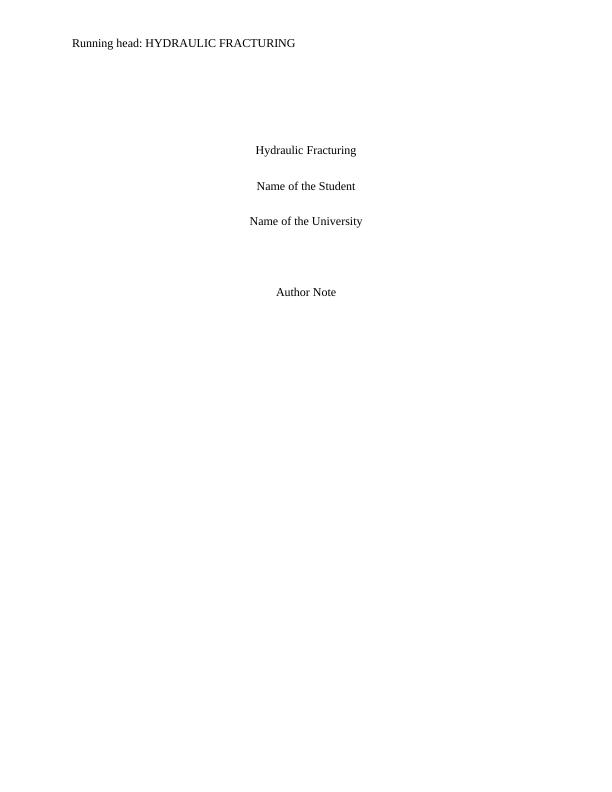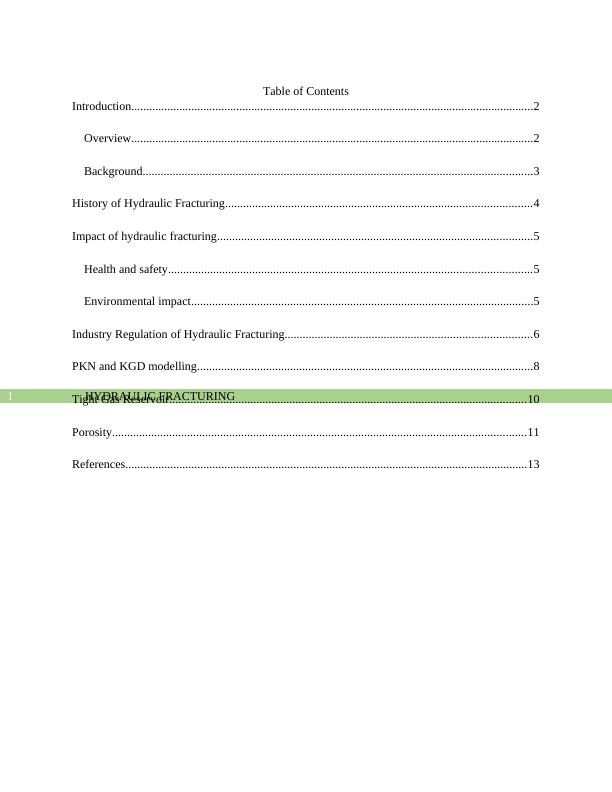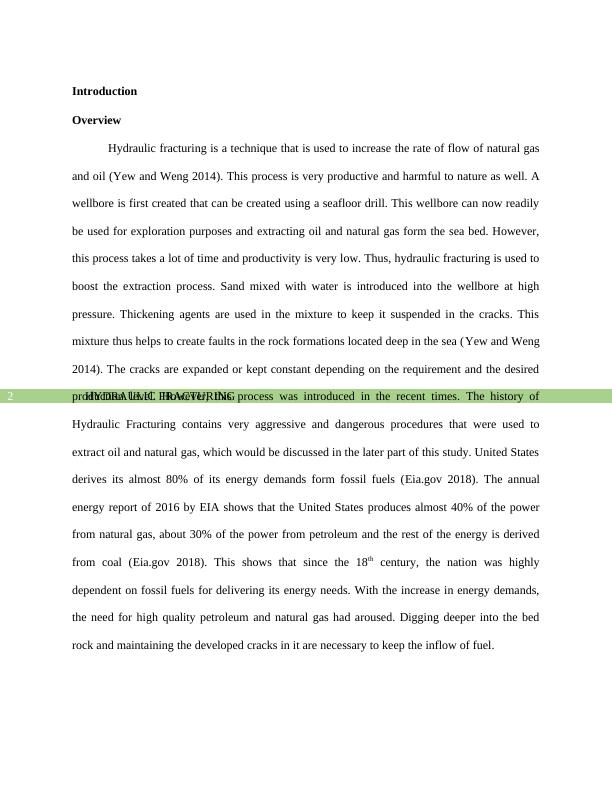Assignment on Hydraulic Fracturing
17 Pages4580 Words71 Views
Added on 2021-04-17
Assignment on Hydraulic Fracturing
Added on 2021-04-17
ShareRelated Documents
Running head: HYDRAULIC FRACTURINGHydraulic FracturingName of the StudentName of the UniversityAuthor Note

HYDRAULIC FRACTURING1Table of ContentsIntroduction......................................................................................................................................2Overview......................................................................................................................................2Background..................................................................................................................................3History of Hydraulic Fracturing......................................................................................................4Impact of hydraulic fracturing.........................................................................................................5Health and safety.........................................................................................................................5Environmental impact..................................................................................................................5Industry Regulation of Hydraulic Fracturing..................................................................................6PKN and KGD modelling................................................................................................................8Tight Gas Reservoir.......................................................................................................................10Porosity..........................................................................................................................................11References......................................................................................................................................13

HYDRAULIC FRACTURING2IntroductionOverviewHydraulic fracturing is a technique that is used to increase the rate of flow of natural gasand oil (Yew and Weng 2014). This process is very productive and harmful to nature as well. Awellbore is first created that can be created using a seafloor drill. This wellbore can now readilybe used for exploration purposes and extracting oil and natural gas form the sea bed. However,this process takes a lot of time and productivity is very low. Thus, hydraulic fracturing is used toboost the extraction process. Sand mixed with water is introduced into the wellbore at highpressure. Thickening agents are used in the mixture to keep it suspended in the cracks. Thismixture thus helps to create faults in the rock formations located deep in the sea (Yew and Weng2014). The cracks are expanded or kept constant depending on the requirement and the desiredproduction level. However, this process was introduced in the recent times. The history ofHydraulic Fracturing contains very aggressive and dangerous procedures that were used toextract oil and natural gas, which would be discussed in the later part of this study. United Statesderives its almost 80% of its energy demands form fossil fuels (Eia.gov 2018). The annualenergy report of 2016 by EIA shows that the United States produces almost 40% of the powerfrom natural gas, about 30% of the power from petroleum and the rest of the energy is derivedfrom coal (Eia.gov 2018). This shows that since the 18th century, the nation was highlydependent on fossil fuels for delivering its energy needs. With the increase in energy demands,the need for high quality petroleum and natural gas had aroused. Digging deeper into the bedrock and maintaining the developed cracks in it are necessary to keep the inflow of fuel.

HYDRAULIC FRACTURING3BackgroundNatural gas is being promoted as a cleaner source of energy. It emits low amounts ofcarbon dioxide and oxides of nitrogen into the atmosphere as biproduct to combustion. Thus,coal and petroleum got replaced wherever feasible. The calorific value of natural gas wascomparable to that of petroleum but not greater (Howarth 2014). However, the concerns for theenvironmental impact of the greenhouse footprint of fossil fuels had led to the fast yet steadyimplementation of hydraulic fracturing. Natural gas is commonly found in small pores in a typeof sedimentary rock formation known as ‘shale’ (Carroll 2014). These rocks are formed underhigh pressure and thus they are very high in density. Oil can easily be extracted from wellborescreated by drilling on the sea bed. However, natural gas could not be extracted from thisprocedure. Exploration for natural gas can be conducted at almost every shale layer deposit in theworld as these formations are guaranteed to contain deposits of natural gas (Väizene et al. 2014).Thus, the researchers started off by creating bigger cracks that would not collapse on itself toachieve the smooth extraction of natural gas and petroleum. Some areas are rich in natural gasand some are not. Exploring every single site is physically and economically impossible.Hydraulic fracturing thus provides an economical technique to extract natural gas from the shalerocks. However, various environmental impacts of using this technique was observed. Some ofthe impacts directly affected the living beings and some took its course over some years to affectthem (Vinciguerra et al. 2015). Accidents at the extraction sites were common due to the natureof the natural gas and due to the procedures used for extracting it. Therefore, various regulationswere developed to minimize the impact of hydraulic fracturing on the environment. Theseregulations were imposed on the Oil and Gas industries to standardize the process and reduce therisks to the workers and to the nearby residents as well (Ewen et al. 2015).

End of preview
Want to access all the pages? Upload your documents or become a member.
Related Documents
Report on Ecology and Sustainability: Hydraulic fracturing in the NT(Northern Territory)lg...
|16
|4392
|124
English - About Fracking | dOCUMENTlg...
|4
|830
|15
Economics Assignment Sample (solved)lg...
|5
|648
|57
Geomechanics for Unconventional Reservoir Production: Importance and Analysislg...
|31
|8186
|488
Advantages and Disadvantages of PESTELlg...
|11
|3249
|324
Hydraulic Fracturing Research 2022lg...
|5
|1767
|13
